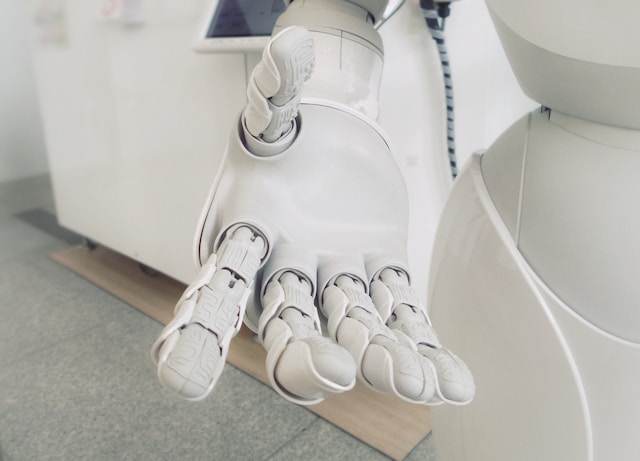A factory full of robot employees used to seem like something out of a science fiction film, but now, it’s only one example of how businesses are using AI. In facts, modern generative AI manufacturing (AI) has several outstanding advantages for manufacturers. Let us share top use cases of how AI in manufacturing that you should definitely explore.
#1 — Cobots Work With Humans
Collaborative robots, often known as cobots, typically operate alongside human employees as an extra pair of hands. While autonomous robots are trained to do a same job continuously, cobots may learn new tasks. They can also identify and avoid obstacles, and their agility and spatial awareness allow them to operate alongside — and with — humans.
Manufacturers generally use cobots for heavy lifting jobs or on manufacturing assembly lines. For example, cobots in automotive facilities may lift heavy automobile parts and hold them in position while human workers secure them. Besides that, cobots can also find and recover products in vast warehouses.
#2 — RPA Automate Time-Consuming Operations
While cobots are used on the front lines of production in manufacturing, robotic process automation (RPA) software is more beneficial in the back office. RPA software can handle high-volume, repetitive operations such as data transmission across systems, inquiries, computations, and record maintenance. RPA software automates processes like order processing so that individuals don’t have to manually enter data and, as a result, don’t have to spend time looking for entering errors.

#3 — Digital Twins Help Increase Performance
A digital twin is a virtual replica of a real object that gets data from the physical counterpart’s smart sensors. It provides knowledge about the object by utilizing artificial intelligence and other technologies. As a result, companies may track a lifespan of any object and get vital notifications, such as the need for inspection and repair. For example, sensors installed in an aviation engine will broadcast info to the engine’s digital twin every time the jet lands or takes off, delivering important information about the engine’s performance to the airline and manufacturer. This data may be used by an airline to run simulations and forecast problems.
#4 — Predictive Maintenance Increases Safety While Lowering Expenses
To anticipate service demands, manufacturing facilities, railways, and other heavy hardware users are increasingly resorting to AI-based Predictive maintenance (PdM). Companies risk losing precious time and money if equipment is not maintained on schedule. On the one hand, doing equipment maintenance too early wastes money and resources. Waiting too long, on the other hand, might cause considerable wear and strain on the equipment. The latter can likewise endanger workers’ safety. PdM systems can also assist businesses in predicting what replacement components will be required and when.
#5 — Lighting-Free Manufacturing Save Money
The lights-out factory is a unique AI in manufacturing use case that has a great potential. It is meant to utilize a fully robotic workforce and function with minimum human involvement by utilizing AI, robotics, and other next-generation technology. Lights-out factories have the potential to save manufacturers money since robotic employees do not have the same requirements as their human counterparts. A factory consisting of robots, for example, does not require lighting or other environmental controls such as air conditioning and heating. Manufacturers can save money by changing these services. As a result, robotic employees can work around the clock without getting tired or sick and can generate more things than their human counterparts while making fewer mistakes.
AI Changing the Manufacturing
Artificial intelligence is playing a transformative role in the manufacturing industry, reshaping processes, improving efficiency, and enabling innovation across various domains. From cobots and digital twins to RPA software and PdM solutions, artificial intelligence brings manufacturing to a whole new level.

